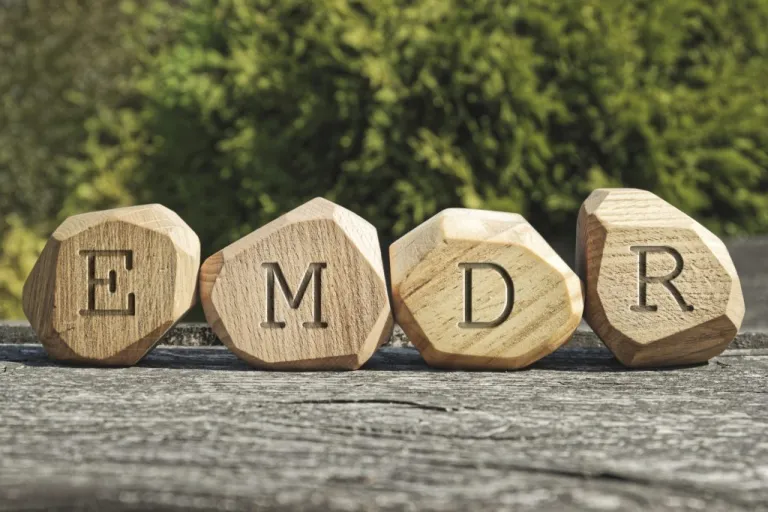

New Treatment Options
EMDR
“We may not be responsible for the world that created our minds, but we can take responsibility for the mind with which we create our world.”
-Gabor Mate
EMDR (Eye Movement Desensitization and Reprocessing) is a psychotherapeutic modality that is more similar to mindfulness-based therapy than traditional talk therapy. The treatment was developed by Francine Shapiro, Ph.D. in 1987 after noticing that moving her eyes from side to side had a positive or desensitizing effect on her emotions. EMDR was originally developed to reduce symptoms of hyper-vigilance, intrusive memories and related disturbances in soldiers returning from the Vietnam war and female victims of sexual assault. It was found that eye movements alone did not have a therapeutic effect, and so she then added a cognitive component and developed the current standard procedure: Eye Movement Desensitization (EMD). In 1990 EMD became EMDR adding the “R,” which stands for reprocessing, which is the therapeutic approach we know today.
EMDR uses the Adaptive Information Processing (AIP) model, developed by Francine Shapiro, Ph.D., which recognizes that your brain stores normal and traumatic memories and information differently. This theory posits that when you experience normal events your brain stores information smoothly, and stores these memories so they connect to other memories. However, during distressing events networking does not occur in the same way. Traumatic experiences become trauma when our fight-or-flight senses try to protect us from a frightening or dangerous event and fail.
In EMDR therapy the root of mental health issues stem from unprocessed memories stored in the brain and body. The brain can disconnect what you experience (see, hear, feel) and what your brain stores through language, resulting in not remembering situations, experiences, memories, and blocking or shutting down of emotions and feelings. This can result in difficulty being able to heal or to work through these experiences. A traumatic experience is like a log stuck in a river blocking the flow of water. An analogy is that EMDR helps to unjam the log to allow for the river or your brain to process information more freely and effectively.
EMDR may be considered a bottom up therapeutic approach, meaning that instead of the rational mind approaching the instinctive mind, it addresses the instinctual mind to move into a more adaptive mode. EMDR could be considered to be similar to CBT (Cognitive Behavioral Therapy) in that it involves identifying and altering thoughts in addition to discussing while remembering a distressing event.

EMDR works by activating both brain hemispheres simultaneously through bilateral stimulation (i.e., eye movements, or rhythmic tapping) to alter the way memory is stored in the brain, which allows one to process it, leading to adaptive resolution decreased emotional charge (a.k.a., desensitization) and increased linkage to positive memory networks (a.k.a., reprocessing).
EMDR therapy helps clients to work through distressing memories, sensations and emotions with the goal to resume adaptive and healthy processing. An experience, situation or person which may have previously triggered a negative response may no longer have the same impact after EMDR treatment. A client may begin to feel the positive effects of EMDR after the first few sessions and/or the difficult or distressing memory will feel less emotionally charged.

“The speed at which change occurs during EMDR contradicts the traditional notion of time as essential for psychological healing.”
-Bessel A. van der Kolk, M.D., Professor of Psychiatry,
Boston University School of Medicine
EMDR is integrative, works quickly, does not necessitate prolonged exposure, which some clients may experience as re-traumatizing, and requires no homework. In addition, clients often report experiencing a sense of joy, openness, and deep connection with others as a result.
“Perhaps the greatest joy we have as EMDR therapists is to hear our patients, when they have finished reprocessing their memories, tell us things like…”It’s over. Now it’s distant. It’s in the past.” And when they come back in the following sessions they say: “I remember, but it doesn’t bother me anymore.”
-Esly Regina Carvalho, Ph.D.
EMDR began primarily and is used to treat post-traumatic stress disorder (PTSD). However, it can also be used to treat: acute stress disorder, adjustment disorders, low self-esteem, anxiety disorders, depressive disorders, complicated grief, dissociative disorders, eating disorders, gender dysphoria, body dysmorphia, obsessive-compulsive disorders, phobias and chronic pain. From Francine Shapiro, Ph.D.’s AIP model, EMDR is considered appropriate for addressing any disturbance that exists in memory that has not integrated into adaptive learning.
EMDR was first designed to alleviate distress associated with traumatic memories often associated with PTSD (post-traumatic stress disorder).
There are over 20 controlled studies looking at the effects of EMDR. The Department of Defense/Department of Veterans Affairs Practice Guidelines place EMDR in the highest category recommended for all trauma populations. The World Health Organization (2013) recommends trauma-focused CBT and EMDR for children, adolescents and adults with PTSD. The American Psychiatric Association Practice Guideline (2004) stated that EMDR, CBT and SSRIs are recommended first-line treatments for trauma. The International Society of Traumatic Stress Studies have designated EMDR as an effective treatment for PTSD.
Counter literature suggests that when comparing EMDR to imaginal exposure, research shows that there are few or no differences. This means that EMDR’s results may derive from the exposure of visualizing traumatic imagery, which is part of the EMDR therapeutic process.
Results from Khan et al 2018 meta-analysis comparing the effectiveness of CBT vs. EMDR found that EMDR more effective in the alleviation of post-traumatic and anxiety symptoms as compared to participants treated with CBT. No significant effects were found in EMDR for depression. There was no significant difference between CBT and EMDR at the three-month follow-up.
Once the clinician and client agree that EMDR therapy is a good fit, initial sessions involve gathering background psychosocial history, identifying the client’s treatment goals, and improving stress management skills.
When the client is ready for further stages of EMDR therapy, the clinician will invite the client to focus on an event or memory. Attention will be paid to a negative image, belief, emotion, and body feeling related to that event, and then to a positive belief that would indicate the issue was resolved.
The client focuses on the upsetting event while the therapist begins sets of agreed-upon bilateral stimulation (BLS), which is typically either the therapist’s hand/fingers moving back and forth to allow for the client’s rapid eye movement, rhythmic tapping (either by the client self-tapping, or the clinician tapping for the client), using an alternating light/vibration device, or an online device (such as a colored ball moving back and forth).
The client is guided by the therapist to notice what comes to mind after each set of BLS. The client may experience shifts in images, memories, emotions, bodily sensations, and beliefs pertaining to the event.
The client has full control to pause at any moment if needed throughout the session, which is discussed and agreed upon by both the clinician and the client. The sets of BLS are continued until the processed event becomes less distressing. EMDR can be used within a standard talk therapy, as adjunctive therapy with a separate clinician, or as a treatment all by itself.

One EMDR session is typically anywhere from 50-90 minutes in length. Three to six sessions are recommended per each targeted event or memory. A full course of treatment typically involves the reprocessing of multiple events or memories.
On average one to three months of weekly EMDR sessions are recommended. However, each individual client’s experience with EMDR therapy is unique. There are many factors that determine the length of EMDR treatment, such as: the type of problem, the severity and length of exposure to the trauma, and life circumstances.
More complex or longer-term traumas may take between eight to 12 sessions to clear, or sometimes more. If there is a complex symptom structure with multiple distressing events and/or memories it may lengthen the recommended course of treatment. EMDR therapy can be more nuanced particularly when working with developmental trauma, which includes pervasive and persistent experiences from childhood, which can often contribute to dissociative symptoms. In these cases it is important for the EMDR process to progress slowly. In some cases it is necessary to stay working on building somatic resourcing and mindfulness techniques for one month or more before moving into phases 3-8 of EMDR treatment which is when reprocessing of distressing material occurs. In some cases it is important to take time to pause. Sometimes a more condensed reprocessing protocol is recommended to address a current stressor before moving onto more extensive reprocessing.
It is important for the client to be safe from harm and in a relatively stable state first in order to reprocess distressing memories, events and material. This can be cultivated by guiding the client through somatic resourcing and experiencing, meditation, grounding and mindfulness exercises prior to beginning phases 3-8 of EMDR therapy. It is not recommended to begin EMDR therapy when a client is actively using substances. If the client is currently using substances and wishes to pursue an EMDR treatment, it is recommended be abstinent for at least 12 hours before a reprocessing session. EMDR is not recommended to treat traumatic brain injuries or for a mental health condition as a result of an injury or physical injury to the brain.
You may feel emotionally drained after sessions. The most common negative effects of EMDR therapy are negative feelings or thoughts between sessions. You may feel worse before you begin to feel better depending on your individual healing process. As distressing material resurfaces to be reprocessed it may feel uncomfortable at times. A trained EMDR therapist should explain this prior to beginning EMDR therapy, and ongoing support for clients to continue processing in between sessions.
